The size of the latest transistors (as of 2017) is 10nm, which makes transistor features on the order of tens of atoms in size. Such small devices become harder to produce as making such feature sizes relies on more advanced equipment which comes at a cost.
But the problem with small transistors does not end there. When transistor gates become very small (atoms across), quantum effects–which are normally insignificant such as electron tunneling–become apparent and can have detrimental effects.
Take electron tunneling, for instance: If the gate becomes too thin and electrons can tunnel through then charge stored on the gate can be lost which requires the user to replace that lost charge. The result is a transistor that consumes more current which in turn results in more heat dissipation. Individual transistors (even if very leaky) have near immeasurable amounts of current loss and temperature rise but when several billion devices are placed on a single piece of silicon, the effect adds up and becomes a serious problem. But current does not just leak from the gate; current can tunnel from the source to the drain if the two are in close proximity which can impede a transistors ability to control current.
Enter Molybdenum Disulphide
So how can devices become smaller? There are many ideas being developed by many engineers and researchers alike, including the use of diamond, graphene, and even organic compounds.
Recently, a team from Stanford
created a 1nm transistor using molybdenum disulfide but is difficult to produce. This work was further advanced by researchers at the
IEEE International Electron Devices Meeting in December who created working complex circuits using realistic manufacturing techniques.
However, a group (also from Stanford) demonstrated how 10nm devices can readily be produced
using molybdenum disulfide. But what makes the devices made by Stanford impressive is how they were produced and their exhibited characteristics which could make them much faster than silicon-based devices.
MoS2 devices. Image courtesy of Stanford University.
Read More
According to the Stanford researchers, when molybdenum disulfide transistors are on the scale of 10nm, electrons moving between the drain and source begin to
exhibit ballistic conduction, which is when electrons stop scattering as they move through the material. This scattering is what causes resistivity in materials—without it, a material essentially has 0 resistance.
Therefore, electrons in molybdenum disulfide transistors could pass through unaffected by the semiconducting material and hence could operate much faster compared to their silicon counterparts.
Eric Pop (an EE at Stanford) estimates that one in five electrons undergo ballistic conduction in the 10nm devices. However, Eric Pop believes that, if the quality of the semiconductor material is improved and the transistor reduced in size, this ballistic conduction number will increase. This would result in higher-speed devices which can conduct more current without heating up as much as a silicon device.
The devices, however, are not just small and fast. They could be easily manufactured using similar techniques to silicon devices. Silicon chips are so successful due to their ability to be produced on massive scales using layered techniques whereby each layer is either added or subtracted from a single wafer of silicon (and each wafer can produce hundreds of devices).
Stanford researchers were able to produce the 10nm devices by taking a silicon wafer and growing molybdenum disulfide on top. Then, a gate was grown on top of the semiconductor by first depositing 20nm of aluminum and then allowing it to oxide (where it shrinks to 10nm).



